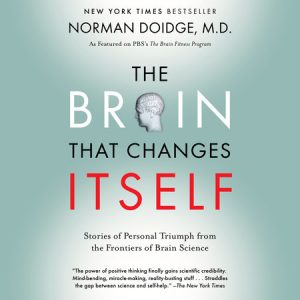
Stories of personal triumph from the frontiers of brain science.
Author: Norman Doidge
Over the years I have been interested in the science of brain plasticity and the ability of the human brain, at any age, to learn and grow new neural connections. In this book Norman Doidge explores the scientists and the science of this new movement by learning about the people who have been helped and sharing their stories. This makes the book really easy to read and to connect too, also its not too over your head, Norman is a good science communicator. He works as a psychiatrist, psychoanalyst and researcher so he is used to talking to normal people and helping them understand what is going on in their brains and minds.
We meet many people in this book who have found brain plasticity the break through for learning to help with physical and psychological disabilities. I liked Cheryl Schlitz, a very motivated woman who feels like she constantly falling. 24/7 she has the feeling that she is falling, this means she cannot stand up, walk, or do anything without this crippling sensation, and she often falls over but the sensation continues. She has a problem with her Vestibular apparatus which is the sensory organ in the brain which helps us to orientate ourselves in the world and give us balance. Feeling like this has had a catastrophic effect on her life and made her feel extremely fatigued and also develop anxiety.
But with the help of a researcher Bach-y-Rita and his team she has learnt over time with the help of a machine he invented to rewire her brain. They believe that the damaged vestibular system is sending random noisy messages to the brain which is causing her to feel the way she does. The machine helps to reinforce the signals from the healthy parts of her brain and also recruits new neural pathways which over time take on the roles of the damaged areas. This means that over a period of a year Cheryl was able to train her brain so that she no longer feels “wobbly”, she is now able to live without the machine and is much better health wise.
The books goes on to cover children with learning physical and learning disabilities, people with phantom limb syndrome and those with psychological issues, it shows that with time and effort they can learn to rewire neural networks and overcome or manage their disabilities. I find this really helpful as a person living with ME/CFS/FM who has a damaged stress response. Pre-ME/CFS/FM I thrived on stress and really enjoyed living and working in stressful environments and after I found even small amounts of stress would trigger a full-blown fight, flight, or freeze response. Over the years I have learnt that I can overcome this by retraining my brain when it comes to stress. I have made a conscious effort to stop or slow down when I feel stress coming into my body and over time have increased my resilience to stress.
Also, like many with an overactive stress response, I developed anxiety. My brain would rush to patterns of thinking that made me jump to the worst outcome and to low self-esteem. None of this helped me on my recovery as I would often think that it was all my fault, you cannot find home and flexibility when you brain is in the pattern of thinking. Using the practice of meditation, I have re-trained my brain to stop running down those well-worn pathways and have instead created a higher level of self-awareness and self-esteem.
None of this has been easy or fast but it has happened because of books like this and others I the area of brain plasticity, mindfulness, and meditation. I find it fascinating that we can help to grow and improve our brains over time, no matter what. “Neurons that fire together, wire together” this means that the more often we try new physical patterns, the higher chance we have of creating new pathways in our brain. With the research outlined in this book it has been proven that if we lose a physical or mental process we can, with the right training, rewire a new pathway and use another part of the brain or body to perform a task. This opens the door for so much possibility for our ongoing development as humans and lets us know that we have not even scraped the surface to the capacity of the human brain and body.
Elizabeth McGougan FO
If you are a CCIS member and would like to borrow this or other books from CCIS, please contact your Field Officer or register here : LIBRARY KIOSK
